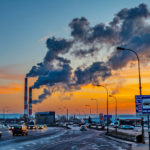Digital and carbon footprints: the legacy of humankind in the 21st century
Climate emergency is one of the greatest challenges facing humanity. Besides transport, the agro-livestock or heavy industry sectors are major contributors to greenhouse gas emissions. Our digital activity, linked to our traceable digital footprint, also contributes to our carbon footprint.

Every time we send an email, it has a carbon footprint attached to it. The same goes for our WhatsApp messages. And the evenings we spend watching Netflix. Incredible as it may seem, all these actions contribute to a greater or lesser extent to increase global greenhouse gas emissions. The digital devices, computers and networks we use for these purposes all run on electricity, and therefore generate carbon dioxide emissions..
At the same time, all our digital interactions with these devices define our digital footprint. This term is defined as one's unique set of traceable online digital activities. This includes the information collected both passively (through 'cookies' on the web pages we visit) and actively (social media posts). This information is stored on servers, usually hosted in large data centers.
The term 'carbon footprint', on the other hand, refers to the total greenhouse gas emissions by an individual, organization, event or product. According to the Association for the Environment and Against Climate Change (AMA) this is something we should all be worried about: “These gases are concentrating on the atmosphere at a scale that we’ve never seen before in human history, which will cause the global average temperature to rise by over one degree Celsius, in a very short period of time. This is causing the planet to veer off from the climatic stability that prevailed during the Holocene, and which allowed our civilization to develop.”

The digital and carbon footprints are two unavoidable consequences of humankind activity in the 21st century and are linked to each other. Multiple studies analyze the impact of users' digital activity on the planet. According to a Greenpeace report published in 2017, the ICT sector was responsible for about 8 percent of the world’s total energy consumption. And, according to the report’s projections, that share was expected to increase. “When we send an email or go online for any other purpose, the data centers, computers and devices that send, filter and deliver our emails or any other content need electricity,” say representatives from Ovo Energy.
The company published a report last year that focused on the impact of the 64 million unnecessary email messages that UK citizens send every day. Users send 11 unnecessary emails every week in average. The study revealed that if every adult in the UK sent one fewer “thank you” email a day, we would save more than 16,433 tons of carbon a year – “equivalent to 81,152 flights to Madrid or taking 3,334 diesel cars off the road.”
On top of this, the bigger the attachment, the more electricity it takes to send, store and receive the email it is appended to. “We’re not saying that an e-mail message will destroy the planet,” say the authors of the report. However, this research “helps illustrate the fact that everything we do has a carbon footprint attached to it. This means that being a bit more aware of this every day, we would could contribute to curb our collective footprint.”
The climate emergency is one of the greatest challenges facing humanity. Greenhouse gas concentrations in the atmosphere reached yet another high in 2018. According to the World Meteorological Organization, the last time carbon dioxide concentrations were this high was three million years.
"Everything we do has a carbon footprint attached to it"
For Francisco Victoria Jumilla, head of the environmental and climate change service of the Autonomous Community of the Region Murcia, Spain, there is no doubt that, in terms of carbon footprint, the transport sector is the greatest offender. And this includes, not only driving around in our cars, but other activities such as turning on the heating at home, or buying packaged foods or items from vendors located thousands of kilometers away, also have an environmental impact.
There are different methods and websites we can use to calculate our greenhouse gas emissions, which take into account everything from utility bills, personal travel habits (car or airplane), and consumption of food, products and services.
In the case of companies, this carbon footprint also includes the fuel consumption of the machinery used in manufacturing processes, as well as coolant leaks and specific chemical reactions taking place during said processes. The agroindustry and heavy industry are also two of the biggest contributors to the world’s carbon footprint.

The number of businesses trying to curtain their environmental impact keeps growing. BBVA has pledged to become carbon neutral in 2020. This plan includes measures to facilitate shared transport, efficiency measures and the use of videoconferencing to avoid unnecessary trips. Carbon neutrality is achieved by implementing measures intended to offset the amount of carbon dioxide released into the atmosphere.
There are many ways that people and businesses can reduce their carbon footprint. “For example, limiting the consumption of fossil fuels in transport or emissions of other greenhouse gases, such as methane in livestock farming or nitrous oxide in agriculture,” explains Victoria Jumilla. Renewable energies can also contribute to minimize our carbon footprint: “Every square meter of solar panel installed saves 65 kilograms in carbon dioxide emissions.” And harvesting rainwater. “For every cubic meter of water we harvest we prevent 0.4 kilograms of carbon emissions, which is the amount emitted by drinking water suppliers.
Adopting this type of measures as soon as possible is essential to ensure the survival or our Planet just as we know it today. And that’s one thing that AMA is certain about: “Letting the world’s average temperature increase by two degrees Celsius could trigger positive feedback loops that could lead, within decades, to melt the polar ice caps, cause sea levels to rise over two meters, and render large areas of the planet inhabitable.”